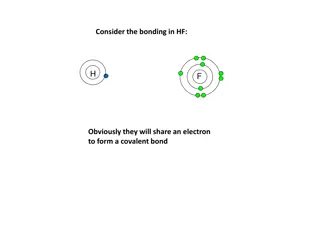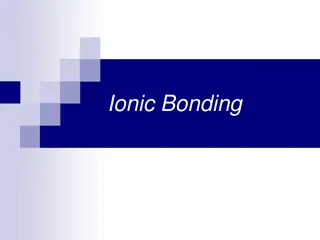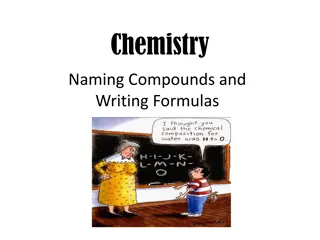Understanding Bonding in Ionic, Covalent, and Metallic Compounds
Explore the concepts of ionic, covalent, and metallic bonding through an investigation conducted by Vanderbilt Student Volunteers for Science. Learn about the different types of bonding, properties of ionic and molecular compounds, and the conductivity of metals. Discover the importance of determining if a compound is ionic or covalent and delve into the world of static and current electricity in relation to metallic and molecular compounds.
Download Presentation

Please find below an Image/Link to download the presentation.
The content on the website is provided AS IS for your information and personal use only. It may not be sold, licensed, or shared on other websites without obtaining consent from the author. Download presentation by click this link. If you encounter any issues during the download, it is possible that the publisher has removed the file from their server.
E N D
Presentation Transcript
VANDERBILT STUDENT VOLUNTEERS FOR SCIENCE http://studentorgs.vanderbilt.edu/vsvs Investigating Ionic, Covalent and Metallic Bonding Fall 2018
Introduction to Bonding in Ionic and Molecular Compounds and Metals Write the following vocabulary words on the board: ionic compounds, ionic bonds, molecular compounds, covalent bonds, conductors, insulators. Ask students: What are the different types of bonding that can form between atoms? Answer: ionic, covalent or metallic
Ionic Compounds: Show students the model of sodium chloride and explain that the sodium chloride crystal has a repeating pattern of equal numbers of Na+and Cl-ions in 3 dimensions. This is called a crystal lattice. An ionic compound forms between positive and negative ions that are created when atoms either lose or gain electrons.
Molecular Compounds: Show students the plastic bag containing the water molecules. The hydrogen and oxygen molecules are covalently bonded. A molecular compound is made up of atoms that are covalently bonded. Covalent bonds are formed when atoms share electrons.
Metals Metals easily lose valence electrons and become metal ions. Metallic bonds, like covalent bonds, also involve sharing electrons. But in metals, the electrons are shared over millions of atoms, while in molecular compounds, the electrons are shared between just 2 or 3 atoms. For example, in a covalently bonded compound like oxygen (O2), electrons are shared between the 2 oxygen atoms; however, in a metallically bonded compound like a gold bar, electrons are shared over all gold atoms in that bar. You might hear metallic bonding referred to as a sea of electrons for this reason.
Is it Ionic or Covalent? One of the differences in properties between ionic and covalent compounds is the ability to conduct an electrical current when they are added to water. Most metals, unlike either ionic or covalent compounds, conduct electricity as solids and don t need to be dissolved in water. Tell students that they are going to conduct an experiment to determine if a compound is ionic or covalent. Why is the science in this lesson important? See lessons
II. Explaining the Circuit Learning Goals: Students define static and current electricity and observe that metallic compounds conduct electricity and molecular compounds Ask students if they know what the 2 types of electricity are. see lesson Demonstration Learning Goals: Students learn what an LED is, and understand how it is used to show that a circuit is complete. Point out the different parts batteries, circuit connectors, black and red leads, resistor and LED light. Explain LED s to the students: LED s (Light Emitting Diodes) are more sensitive than light bulbs and glow brightly with small currents. Ask the students what you should do to make the LED glow. Touch the black and red lead together to complete the circuit. See lesson
II. Explaining the Circuit Tell the students that electricity flows through some materials better than others. Conductors are materials that allow the movement of electrons through them Now touch the end of one lead wire to the head of the nail and the end of the other lead to the point of the nail. The LED again lights up indicating that the circuit is closed. The metal nail is a good conductor of electricity and completes the circuit. Remember that metallic bonding involves a sea of electrons that allows electrical currents to flow. Repeat with the bottle cap, LED will not light up, indicating the plastic bottle cap is not a conductor. Plastic bottle tops are made from molecular compounds, which have covalent bonds.
III. Conductivity of Solutions of Ionic and Molecular compounds Learning Goals: Students understand that solutions of ionic solutions conduct electricity and solutions of molecular compounds do not. Hand out the jars of solids to each group. Tell students to: Rinse the metal ends of the black and red lead wires by dipping them into the cup of distilled water. Tell the students they will need to do this in between each test, to avoid contaminating the next test sample with the one just tested (make sure that the students know what contamination means). Place the 5 2oz cups containing distilled water on top of the diagram on the instruction sheet. Place the corresponding jar of solid next to the cup. Make sure that the students have the order correct. Students must remove only ONE lid at a time, and replace it after pairs have tested the liquid. Students MUST test the solutions in the order given, 1-5 The non-conductingsolutions are tested first, followed by conductingsolutions. This will help avoid contamination of the solutions.
III. Conductivity of Solutions of Ionic and Molecular compounds contd. 1. Testing distilled water: Put the metal ends of both lead wires in the cup containing distilled water, as far apart as possible, and note if the LED is glowing. (It should not). Remove the leads. 2. Testing water plus sucrose (sugar): Remove the lid of the 1stjar (sugar) and add 1 mini spoon to the water. Stir with a toothpick, and then snap the toothpick in half so it cannot be used again. Repeat the conductivity test. Record your results. Replace the lid on the jar. The LED should not glow. Rinse the metal ends of the wires in the distilled water jar.. 3. Testing water plus glucose: Remove the lid of the 2ndjar (glucose). Repeat the conductivity test. Record your results. Replace the lid. The LED should not glow. Rinse the metal ends of the wires in the rinse cup. 4. Testing water plus sodium chloride (salt): Remove the lid of jar 3 (salt). Repeat the conductivity test Replace the lid. Record your results. The LED should glow. Rinse the metal ends of the wires in the rinse cup. 5. Testing water plus sodium bicarbonate (baking soda): Remove the lid of the 4thjar and repeat the conductivity test. Replace the lid. The LED should glow. Record your results. Rinse the metal ends of the wires in the rinse cup
III. Conductivity of Solutions of Ionic and Molecular compounds contd. Ask students if they can explain the results. Distilled water does not contain ions and thus does not conduct electrical currents. Sugar molecules and glucose molecules are molecular compounds that do not split up into ions in water, and so do not conduct electrical currents Solid salt and solid sodium bicarbonate will not conduct electricity when they are dissolved in water, the units dissociate completely into ions, and so are conductors of an electric current.
IV. Experiment: Using a Polymer to Determine if a Compound is Ionic or Molecular. Sodium Polyacrylate is a superabsorbent polymer A superabsorbent polymer can absorb and retain extremely large amounts of liquid relative to its own mass Point to the diagrams of sodium polyacrylate on their handout. Point out the Na+ions that are replaced by water molecules
Making a gel with sodium polyacrylate. Give each pair a (10 oz) cup containing the sodium polyacrylate (Pre-lesson set-up says to put 1 tsp sodium polyacrylate into a 12 oz cup (the opaque one) and 200mL water into 10 oz cups) and a 10 oz cup containing 200 mL tap water. Tell them to: Pour the water into the cup with the sodium polyacrylate and stir with a spoon. Observe that all the water is absorbed (forms a gel) immediately.
V. Experiment Investigating the Effect of Adding Ionic and Molecular Compounds to Sodium Polyacrylate Fill each well with about 1 tsp of the gel. Add 1 mini spoon sugar to well 1 Add 1 mini spoon glucose to well 2 Add 1 mini spoon sodium chloride (salt) to well 4 Add 1 mini spoon sodium bicarbonate (baking soda) to well 5 Observe what happens to the gel. Ask students: based on the previous experiment, which compounds are ionic or molecular? Answers: Sugar and glucose are molecular. Sodium Chloride and sodium bicarbonate are ionic. Which compounds caused the gel to breakdown? Answers: The ionic compounds The solids that have no effect are the molecular compounds that are covalently bonded. Explanation: The compounds that cause the breakdown contain a combination of metals and non-metals and are ionic compounds (see lesson).
VI. Review How can we distinguish between ionic and molecular compounds using an electrical circuit? How can we distinguish between ionic and molecular compounds using the polymer sodium polyacrylate? Go over the observation sheet with the students.

























